Hide text labels with small values to make charts made in ggplot easier to read
One issue that we often face when making data visualization in reports is text not fitting into graphs. This happened to us when working on reports for the Connecticut Data Collaborative and the Partnership for Strong Communities in Connecticut.
The reports we made, which show key demographic and housing indicators for towns and counties across the state, have bar charts that show the housing cost burden for renters and home owners in the state. In addition to the categories severe burden (50% or greater of income spent on rent), moderate burden (between 30% and 50%), and not burdened (less than 30%), there is a not computed category, which is often quite small. For example, here is the graph for the city of Hartford.
See the light gray not computed bar? It does not have text in it. This was an intentional choice. Here’s what the renters portion of that same chart would like with text in the not computed bar.
Not great, right?
So how do we solve this problem? The answer, which I talked about in my 2024 Cascadia R Conf talk , is to hide small values below a certain level in charts that we make. Let me show what this looks like.
Load Packages and Import Data
To begin, I’ll load my packages (well, actually, just one package).
library(tidyverse)Next, I’ll import my data. I’ve created an RDS file that I’ve posted on GitHub, which I’m importing in the code below.
housing_cost_burden <-
read_rds("https://github.com/rfortherestofus/blog/raw/refs/heads/main/hide-small-values/housing_cost_burden.rds")Having now created a housing_cost_burden , let’s take a look at it.
#> # A tibble: 694 × 4
#> location burden_level pct pct_formatted
#> <fct> <fct> <dbl> <chr>
#> 1 Bethel Not burdened 0.381 38%
#> 2 Bethel Moderate burden 0.352 35%
#> 3 Bethel Severe burden 0.229 23%
#> 4 Bethel Not computed 0.0385 4%
#> 5 Bridgeport Not burdened 0.358 36%
#> 6 Bridgeport Moderate burden 0.260 26%
#> 7 Bridgeport Severe burden 0.332 33%
#> 8 Bridgeport Not computed 0.0494 5%
#> 9 Brookfield Not burdened 0.501 50%
#> 10 Brookfield Moderate burden 0.228 23%
#> # ℹ 684 more rowsYou can see that it has variable for location , burden_level , pct , and pct_formatted (a nicely formatted version of the pct variable).
Make A Basic Housing Burden Plot
Next, let’s make a basic version of the housing burden plot. The plots we made in the housing reports include one town, one county, and the state of Connecticut. To make this plot, I’m taking my housing_cost_burden data, filtering to only include Hartford, Hartford County, and Connecticut, then piping it into ggplot. I use geom_col() to make a stacked bar chart for each location and geom_text() to add the percent labels in the center of each bar.
housing_cost_burden |>
filter(location %in% c(
"Hartford",
"Hartford County",
"Connecticut"
)) |>
ggplot(
aes(
x = pct,
y = location,
fill = burden_level,
label = pct_formatted
)
) +
geom_col() +
geom_text(
position = position_stack(vjust = 0.5),
size = 10,
fontface = "bold",
color = "white"
)The resulting plot can be seen below. Take a look at the text labels in the not computed bars. They go beyond the boundaries of the bar, which isn’t ideal.
We’ll come back to this problem shortly. For now, let’s add a bit of styling and turn our code into a function. I start out the same, but then make tweaks with:
scale_fill_manual()to use brand colors for PSC Housing and reverse the order of the legend (otherwise, it shows up in the opposite order from the bars themselves)scale_y_continuousto remove excess space around the barslabsto adjust the plot labelstheme_void()to set my default theme and thentheme()to make additional tweaks
theme_void()to set my default theme and then theme() to make additional tweaks
housing_cost_burden |>
filter(location %in% c(
"Hartford",
"Hartford County",
"Connecticut"
)) |>
ggplot(
aes(
x = pct,
y = location,
fill = burden_level,
label = pct_formatted
)
) +
geom_col() +
geom_text(
position = position_stack(vjust = 0.5),
size = 10,
fontface = "bold",
color = "white"
) +
scale_fill_manual(
name = "",
values = c(
"Severe burden" = "#266045",
"Moderate burden" = "#73ae90",
"Not burdened" = "#b5b5b5",
"Not computed" = "#d6d6d6"
),
guide = guide_legend(reverse = TRUE)
) +
scale_x_continuous(expand = expansion(0, 0)) +
labs(
fill = NULL,
title = "Housing cost burden for renters"
) +
theme_void(base_size = 13) +
theme(
legend.position = "bottom",
plot.title = element_text(
face = "bold"
),
axis.text.y = element_text(
hjust = 1,
margin = margin(r = 10)
)
)Before I show you the plot that this code makes, I’m going to turn it into a function. The housing_cost_burden_plot function below has nearly the exact same code, but it takes three arguments:
df: a data frametown_to_plot: the town to be plottedcounty_to_plot: the county to be plotted
housing_cost_burden_plot <- function(df, town_to_plot, county_to_plot) {
df |>
filter(location %in% c(
town_to_plot,
county_to_plot,
"Connecticut"
)) |>
ggplot(
aes(
x = pct,
y = location,
fill = burden_level,
label = pct_formatted
)
) +
geom_col() +
geom_text(
position = position_stack(vjust = 0.5),
size = 10,
fontface = "bold",
color = "white"
) +
scale_fill_manual(
name = "",
values = c(
"Severe burden" = "#266045",
"Moderate burden" = "#73ae90",
"Not burdened" = "#b5b5b5",
"Not computed" = "#d6d6d6"
),
guide = guide_legend(reverse = TRUE)
) +
scale_x_continuous(expand = expansion(0, 0)) +
labs(
fill = NULL,
title = "Housing cost burden for renters"
) +
theme_void(base_size = 13) +
theme(
legend.position = "bottom",
plot.title = element_text(
face = "bold"
),
axis.text.y = element_text(
hjust = 1,
margin = margin(r = 10)
)
)
}Putting this code into a function makes it easy to create a plot for any town and county. Let’s make one for Hartford and Hartford County. Here’s the code we would use.
housing_cost_burden_plot(
df = housing_cost_burden,
town_to_plot = "Hartford",
county_to_plot = "Hartford County"
)Running the code, the plot now looks close to what I want, but take a look at that not computed bar. The text labels go outside of its boundaries, making it look visually messy.
Hide Text Labels with Small Values
To fix this problem, I’m going to create a new data frame. Below, I take the original housing_cost_burden data frame, but then adjust the pct_formatted variable. The line mutate(pct_formatted = if_else(pct > 0.07, pct_formatted, NA)) says: “if the value of pct is greater than 0.07, then keep the pct_formatted variable; if not, make it NA ).
housing_cost_burden_2 <-
housing_cost_burden |>
mutate(pct_formatted = if_else(pct > 0.07, pct_formatted, NA))You can see the result below:
#> # A tibble: 694 × 4
#> location burden_level pct pct_formatted
#> <fct> <fct> <dbl> <chr>
#> 1 Bethel Not burdened 0.381 38%
#> 2 Bethel Moderate burden 0.352 35%
#> 3 Bethel Severe burden 0.229 23%
#> 4 Bethel Not computed 0.0385 <NA>
#> 5 Bridgeport Not burdened 0.358 36%
#> 6 Bridgeport Moderate burden 0.260 26%
#> 7 Bridgeport Severe burden 0.332 33%
#> 8 Bridgeport Not computed 0.0494 <NA>
#> 9 Brookfield Not burdened 0.501 50%
#> 10 Brookfield Moderate burden 0.228 23%
#> # ℹ 684 more rowsPractically, what this does is that it removes text from small values (take a look at the NA value in pct_formatted for the town of Bethel in the not computed category: because it is 3.85%, it has been converted to NA ). This is what we want because we know, for example, that if a bar is six percent, it is likely too small to fit the text label.
To see what happens when we use the housing_cost_burden_2 data frame, let’s use our function again, substituting in housing_cost_burden_2 where we previously used housing_cost_burden .
housing_cost_burden_plot(
df = housing_cost_burden_2,
town_to_plot = "Hartford",
county_to_plot = "Hartford County"
)The resulting plot is just what we want: text labels for large bars, no text labels for small bars.
This code doesn’t just work for Hartford and Hartford County. Because the code removes text labels for any single bar that is seven percent or below, it works for, say, the city of Stamford and Fairfield County.
housing_cost_burden_plot(
df = housing_cost_burden_2,
town_to_plot = "Stamford",
county_to_plot = "Fairfield County"
)There are no text labels on the not computed bars.
Of course, this approach works for any burden level, not just not computed. If a town has, say, a severe burden level below seven percent, the text label will not show up for that bar.
Hiding small values in text labels is a great to make your charts easy to read. The approach we’ve shown here, which is more about tweaking our data frame rather than the plotting code, will work on any type of chart. No matter whether you are making a stacked bar chart, a pie chart, or any other type of chart in ggplot, you can use this approach to hide small values, making your chart easy for your reader to comprehend.
Sign up for the newsletter
Get blog posts like this delivered straight to your inbox.
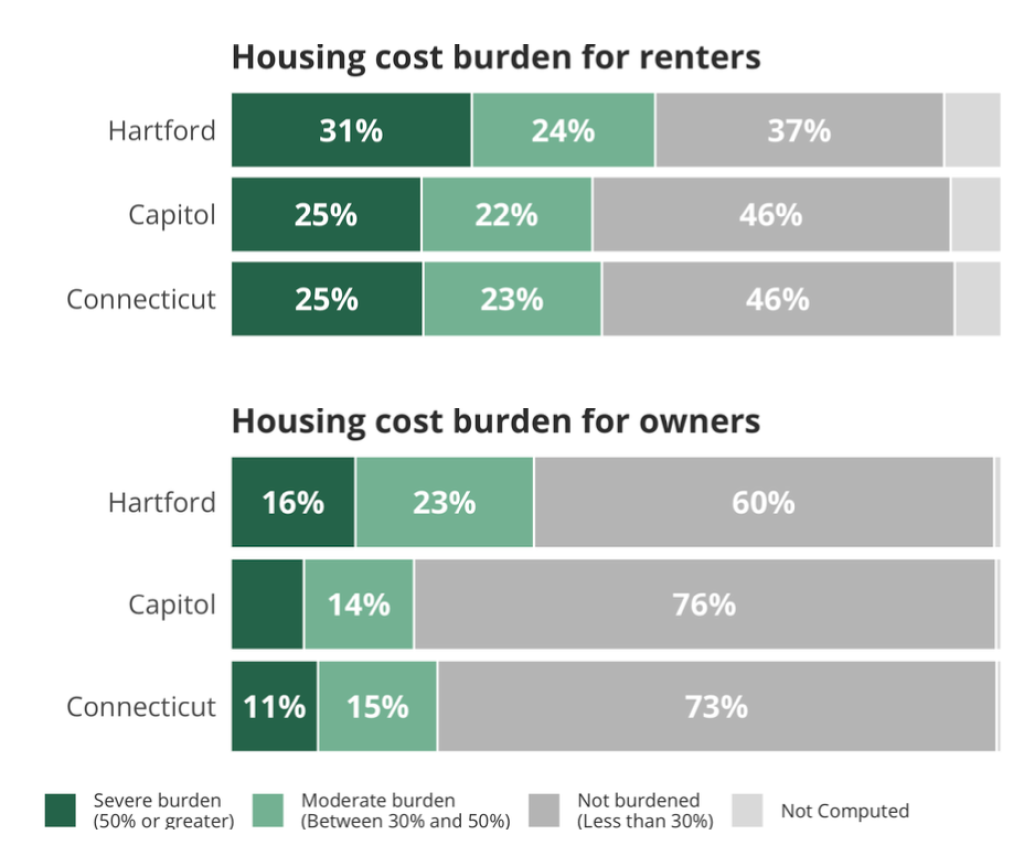
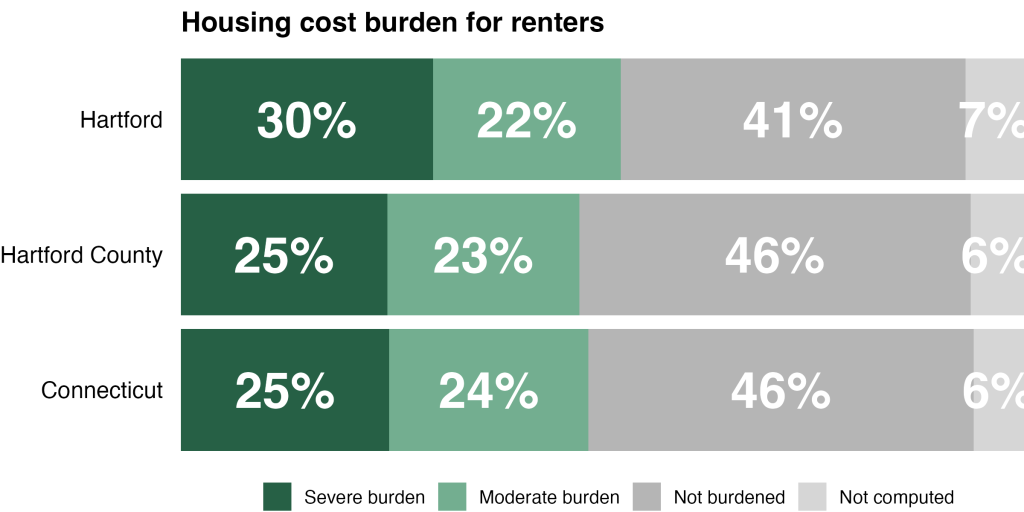

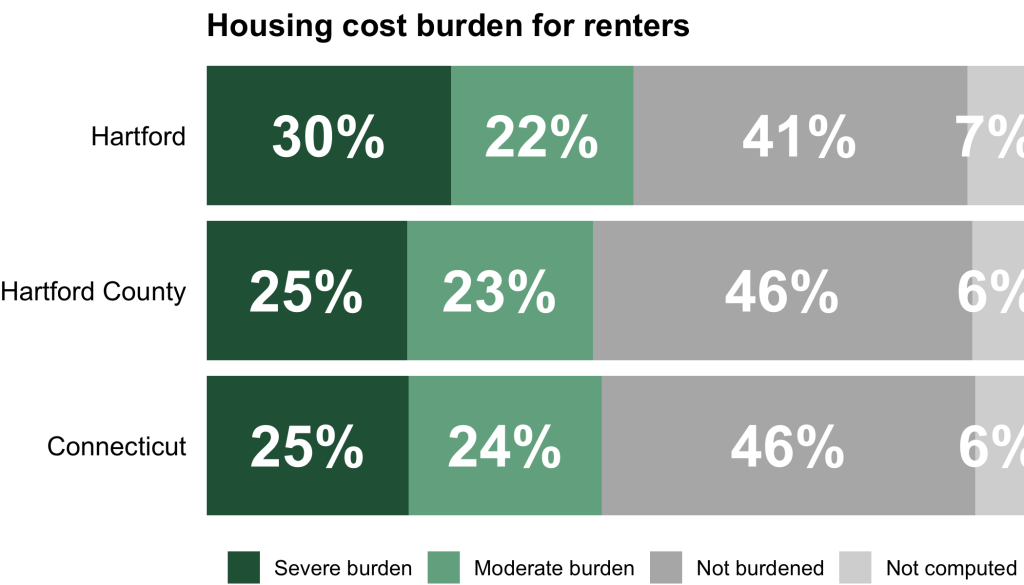
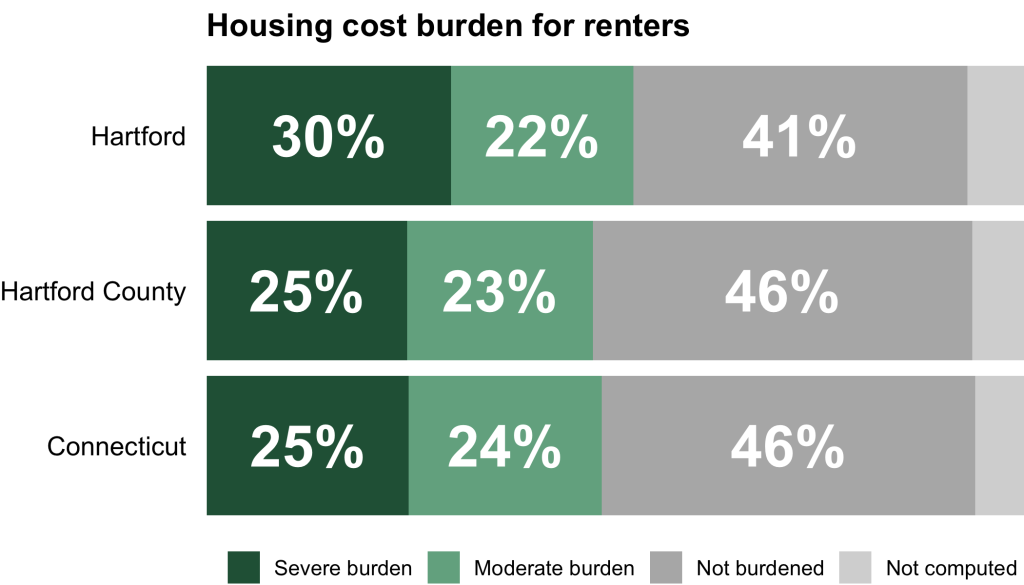
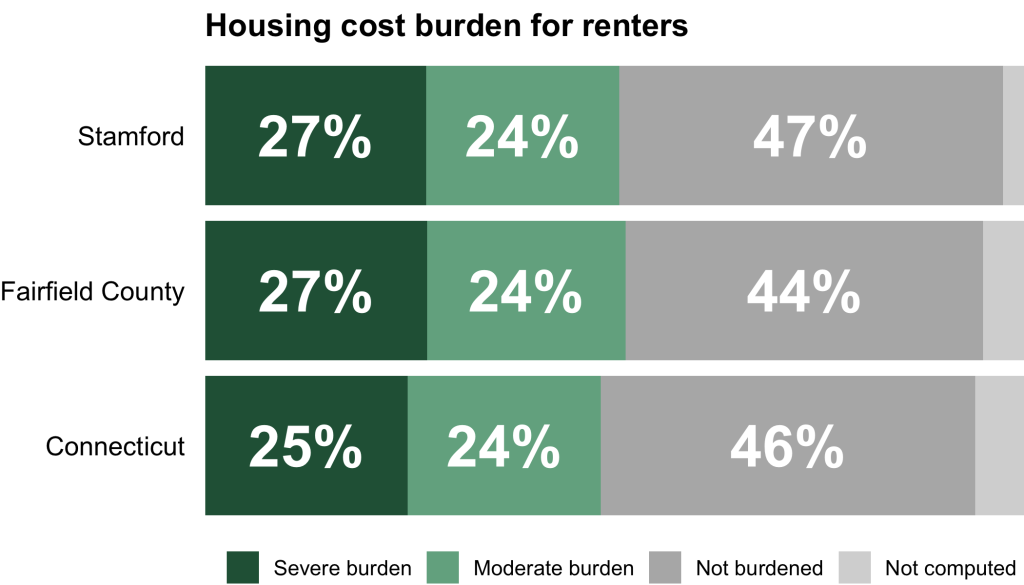
You need to be signed-in to comment on this post. Login.